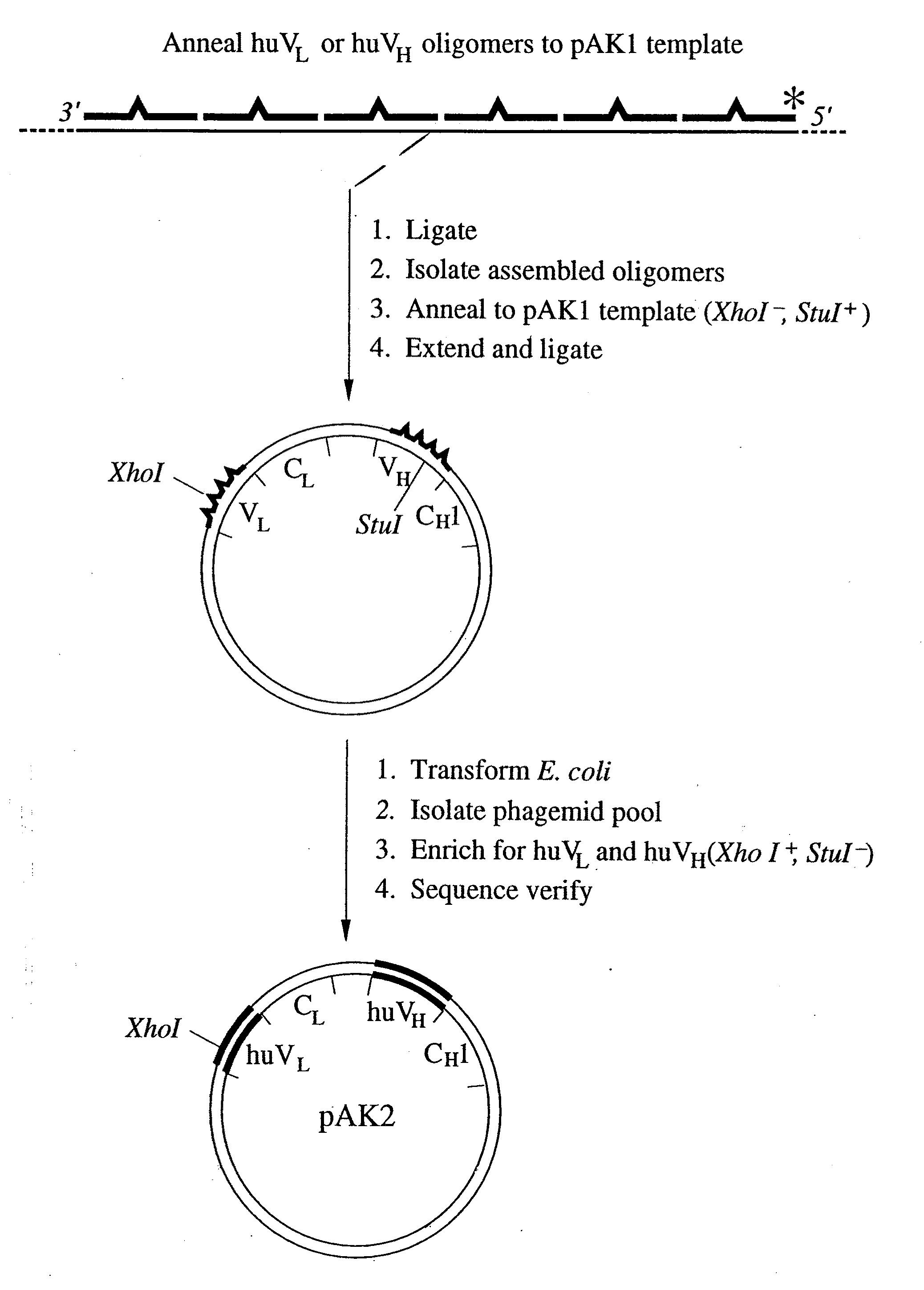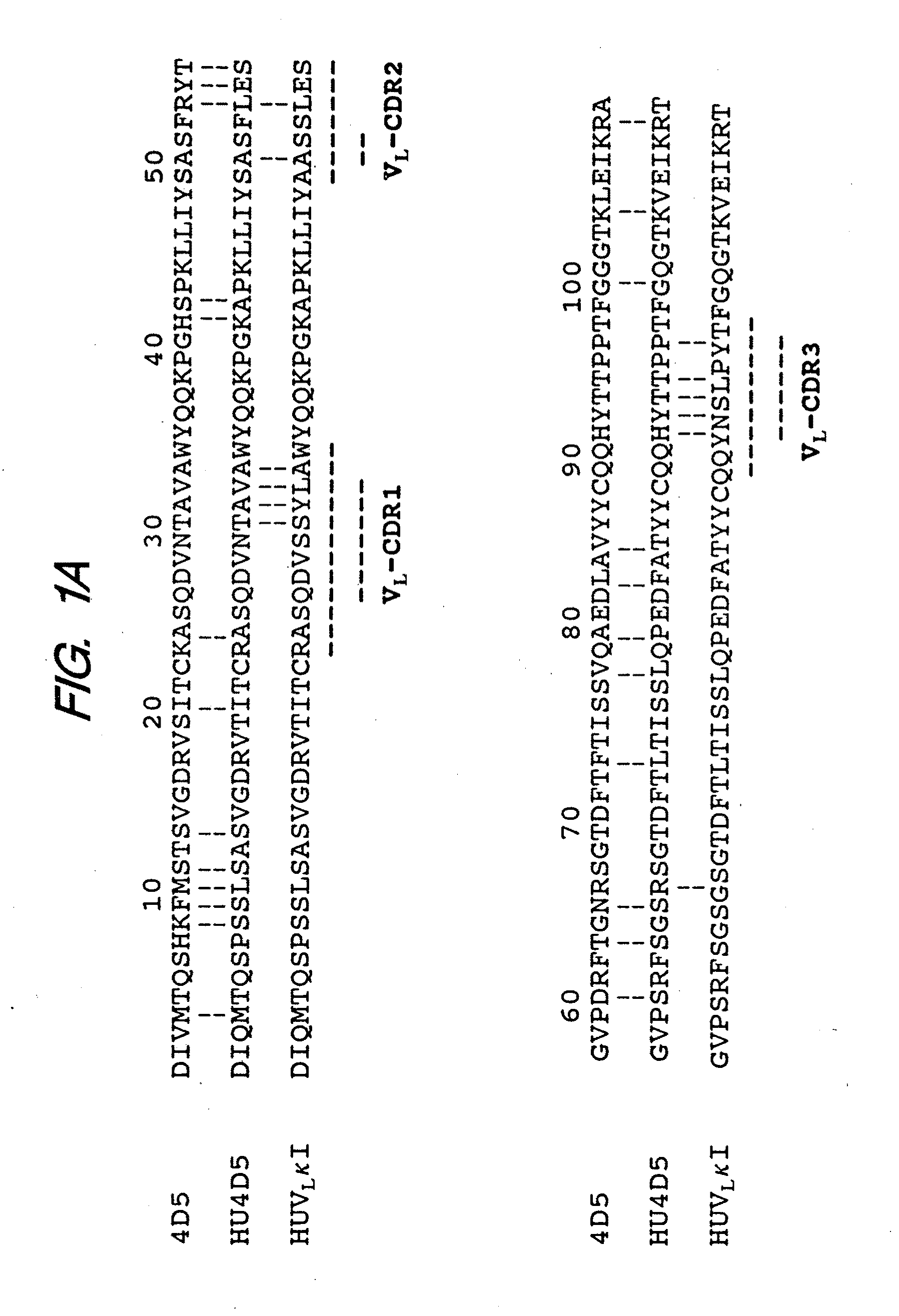Method for making humanized antibodies
a humanized antibody and antibody technology, applied in the field of immunology and cancer diagnosis and treatment, can solve the problems of limited clinical use of rodent monoclonal antibodies, anti-globulin response during therapy, antibody retention of high affinity for antigen and other desired biological activities, and difficulty in achieving current available procedures
- Summary
- Abstract
- Description
- Claims
- Application Information
AI Technical Summary
Benefits of technology
Problems solved by technology
Method used
Image
Examples
example 1
Humanization of muMAb4D5
[0276]Here we report the chimerization of muMAb4D5 (chMAb4D5) and the rapid and simultaneous humanization of heavy (VH) and light (VL) chain variable region genes using a novel “gene conversion mutagenesis” strategy. Eight humanized variants (huMAb4D5) were constructed to probe the importance of several FR residues identified by our molecular modeling or previously proposed to be critical to the conformation of particular CDRs (see Chothia, C. & Lesk, A. M., J. Mol. Biol. 196:901-917 (1987); Chothia, C. et al., Nature 342:877-883 (1989); Tramontano, A. et al., J. Mol. Biol. 215:175-182 (1990)). Efficient transient expression of humanized variants in non-myeloma cells allowed us to rapidly investigate the relationship between binding affinity for p185HER2 ECD and anti-proliferative activity against p185HER2 overexpressing carcinoma cells.
Materials and Methods
[0277]Cloning of Variable Region Genes. The muMAb4D5 VH and VL genes were isolated by polymerase chain ...
example 2
Schematic Method for Humanizing an Antibody Sequence
[0298]This example illustrates one stepwise elaboration of the methods for creating a humanized sequence described above. It will be understood that not all of these steps are essential to the claimed invention, and that steps may be taken in different order.[0299]1. ascertain a consensus human variable domain amino acid sequence and prepare from it a consensus structural model.[0300]2. prepare model of import (the non-human domain to be humanized) variable domain sequences and note structural differences with respect to consensus human model.[0301]3. identify CDR sequences in human and in import, both by using Kabat (supra, 1987) and crystal structure criteria. If there is any difference in CDR identity from the different criteria, use of crystal structure definition of the CDR, but retain the Kabat residues as important framework residues to import.[0302]4. substitute import CDR sequences for human CDR sequences to obtain initial...
example 3
Engineering a Humanized Bispecific F(ab′)2 Fragment
[0326]This example demonstrates the construction of a humanized bispecific antibody (BsF(ab′)2v1 by separate E. coli expression of each Fab′ arm followed by directed chemical coupling in vitro. BsF(ab′)2 v1 (anti-CD3 / anti-p185HER2) was demonstrated to retarget the cytotoxic activity of human CD3+ CTL in vitro against the human breast tumor cell line, SK-BR-3, which overexpresses the p185HER2 product of the protooncogene HER2. This example demonstrates the minimalistic humanization strategy of installing as few murine residues as possible into a human antibody in order to recruit antigen-binding affinity and biological properties comparable to that of the murine parent antibody. This strategy proved very successful for the anti-p185HER2 arm of BsF(ab′)2v1. In contrast BsF(ab′)2 v1 binds to T cells via its anti-CD3 arm much less efficiently than does the chimeric BsF(ab′)2 which contains the variable domains of the murine parent anti-...
PUM
| Property | Measurement | Unit |
|---|---|---|
| temperature | aaaaa | aaaaa |
| ionic strength | aaaaa | aaaaa |
| pH | aaaaa | aaaaa |
Abstract
Description
Claims
Application Information
 Login to View More
Login to View More - R&D
- Intellectual Property
- Life Sciences
- Materials
- Tech Scout
- Unparalleled Data Quality
- Higher Quality Content
- 60% Fewer Hallucinations
Browse by: Latest US Patents, China's latest patents, Technical Efficacy Thesaurus, Application Domain, Technology Topic, Popular Technical Reports.
© 2025 PatSnap. All rights reserved.Legal|Privacy policy|Modern Slavery Act Transparency Statement|Sitemap|About US| Contact US: help@patsnap.com



